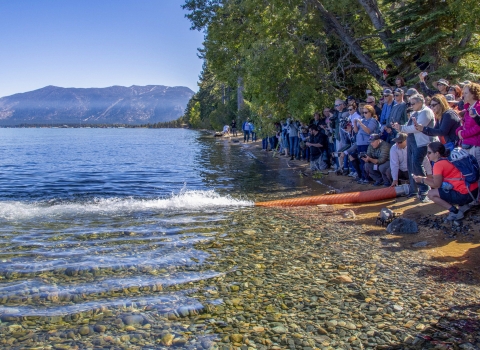Over the past century, waterfowl hunters have helped create and conserve millions of acres of wetland habitat that not only provide places for a wide diversity of wildlife to thrive, but also help in flood control and water purification efforts, and create significant economic stimulus for rural communities. The U.S. Fish and Wildlife Service today proposed to celebrate these hunters’ remarkable achievements and our unique American hunting heritage with a permanent change to the Federal Migratory Bird Conservation Stamp, commonly known as the Duck Stamp.
“Hunters and anglers are the backbone of American conservation, and the Duck Stamp is one of the many ways they contribute to conserving America’s waterfowl and wetlands throughout the country,” said Secretary of the Interior David Bernhardt.
The Federal Duck Stamp has been one of America's most effective and creative conservation tools for over 80 years. While waterfowl hunters 16 years of age or older are required to purchase a stamp each hunting season, anyone can buy one and contribute to conservation. Some 1.5 million stamps are sold each year, and as of 2019, Federal Duck Stamps have generated more than $1.1 billion for the preservation of more than 6 million acres of waterfowl habitat in the United States. A current Federal Duck Stamp is also a free pass into any national wildlife refuge national wildlife refuge
A national wildlife refuge is typically a contiguous area of land and water managed by the U.S. Fish and Wildlife Service for the conservation and, where appropriate, restoration of fish, wildlife and plant resources and their habitats for the benefit of present and future generations of Americans.
Learn more about national wildlife refuge that charges an entry fee.
In addition to being the only domestic conservation revenue stamp, the Federal Duck Stamp is unique in the way it is created. Each year, the Service holds the only juried art competition sponsored by the federal government to select the stamp design.
The Service’s proposal would require entries beginning in the 2020 contest to include one or more visual elements that reflect the theme “celebrating our waterfowl hunting heritage.” They must also adhere to existing contest regulations that require a live portrayal of one or more of the five eligible waterfowl species for that year (brant, gadwall, cinnamon teal, lesser scaup and red-breasted merganser for 2020) as the dominant foreground feature. Contestants will be judged on the quality of their art and how well they illustrate the theme. The contest winner’s art will be made into the 2021-2022 Duck Stamp.
“The Duck Stamp has always been a way for us to celebrate our nation’s waterfowl with beautiful works of art. With these changes we can now also honor the contribution waterfowl hunters have made over so many decades to conserving these species and a host of others that call our wetlands home,” said Aurelia Skipwith, Director of the U.S. Fish and Wildlife Service. “Without the hunting community, we would not have nearly the wealth of protected wetland habitats that we do today, including within the National Wildlife Refuge System, which do so much for local communities and economies. This is our way to acknowledge their significant contributions to conservation.”
“Waterfowlers are rightfully proud of their conservation legacy that’s resulted in more than 6 million acres protected and $1.1 billion contributed over the life of the Duck Stamp,” said Ducks Unlimited CEO Adam Putnam. “Thanks to their work, waterfowl populations have rebounded 56% while others have collapsed. Showcasing the vital connection between hunters and conservation through art is a fitting tribute to the men and women who buy these stamps every year.”
“The success of the Duck Stamp is a testament to the passion, commitment and dedication of duck hunters throughout the years,” said Delta Waterfowl’s Senior Vice President John Devney. “The outcomes in habitat conserved from small potholes in the prairies to refuges in key staging and wintering areas is an incredible legacy that all duck hunters should be proud of. It is a legacy that should be widely celebrated.”
“At a time when a vast majority of birds across the U.S. are declining at alarming rates, waterfowl species have actually increased by 56% since 1970 as a direct result of conservation programs, such as the Federal Duck Stamp Program. Ninety-eight percent of the purchase price for the Federal Duck Stamp goes directly to on-the-ground wetland habitat conservation efforts, which makes this program one of the best returns on investment to conserve critical habitat,” said Congressional Sportsmen’s Foundation President Jeff Crane. “Waterfowl hunters have long been the primary funders of wetland conservation, and we are grateful the U.S. Fish and Wildlife Service continues to recognize the significant financial contributions of sportsmen and women.”
The Service also proposes that all selected contest judges must have an understanding and appreciation of America’s waterfowl hunting heritage and be able to recognize objects related to waterfowl hunting. The 2018 Duck Stamp Contest required the same background for judges as well as for entrants to include one or more visual elements that reflected the contributions waterfowl hunters make to habitat conservation.
The Service will seek comments from the public on the proposed rule for 45 days, beginning with publication in the Federal Register in coming days. The notice will be available at http://www.regulations.gov, Docket Number: FWS-HQ-MB-2019-0105, and will include details on how to submit your comments. An interim copy of the proposed rule is now available.
For more information, please visit: https://www.fws.gov/service/buy-duck-stamp-or-e-stamp.

